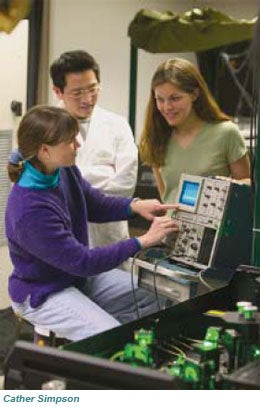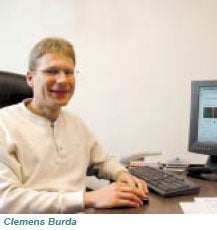|
Two Case chemists have established a research center whose findings may have important applications in the physical sciences, engineering, and biomedicine.
 The Center for Chemical Dynamics (CCD) belongs to the branch of chemistry which explores how matter changes over time. Its objects of study include individual molecules and the exceedingly small bits of matter called nanomaterials. The Center for Chemical Dynamics (CCD) belongs to the branch of chemistry which explores how matter changes over time. Its objects of study include individual molecules and the exceedingly small bits of matter called nanomaterials.
The brainchild of associate professors Cather Simpson and Clemens Burda, the Center was created in 2003 with a grant from the Provost’s Opportunity Fund.
“Much of the research currently ongoing in the CCD is photochemical and photo-physical in nature,” Simpson said. “One of the latest ideas we are pursuing in my lab is a more efficient photothermal therapeutic agent, using what we know about vibrational energy flow through different types of molecules. The successful conclusion of this project will be a new photoactive drug that will kill cancer cells more effectively than what we have now.”
Burda notes that the Center’s research has the potential to help address environmental as well as medical conditions. The prospects range from “using light to clean up the environment to creating better nanoparticlebased sensitizers for the treatment of breast cancer.”
Simpson and Burda were recently joined in their efforts by their chemistry colleague Mary Barkley, a biophysicist who uses fluorescent dyes to study the relationship between structure and function in proteins and other biological molecules. “We recently started working on an HIV viral protein, and are currently testing our hypothesis about how the virus becomes resistant to one class of anti-AIDS drugs,” Barkley said.
 One of the Center’s main goals is to position Case as a regional and national leader in this kind of research. It currently operates a powerful, state-of-the-art array of high-tech equipment to do its work, but with the rapid pace of developments in the field, constant equipment updates are a necessity. One of the Center’s main goals is to position Case as a regional and national leader in this kind of research. It currently operates a powerful, state-of-the-art array of high-tech equipment to do its work, but with the rapid pace of developments in the field, constant equipment updates are a necessity.
“Maintaining and upgrading to make sure the CCD is at the cutting edge of technology is one of the biggest challenges we face,” Simpson said. “In the best of all worlds, our research advances would be limited only by our creativity—not by our access to the necessary equipment.”
The Center’s current research efforts are distributed across several laboratories in the department of chemistry. In addition, CCD members collaborate with faculty in the Case Schools of Engineering and Medicine, and they are working to build collaborations with researchers and educators outside the university as well.
“Training of excellent future scientists is a major part of the CCD vision,” Simpson said. “In the longer term, we would like to provide a resource to the northern Ohio region and beyond, to cultivate high-tech research relationships with students and faculty at four-year colleges and even at the K-12 level.”
|